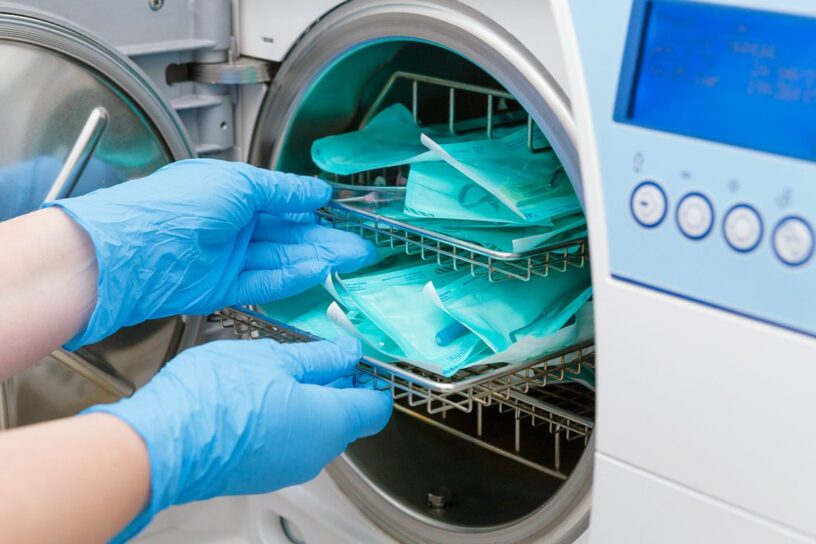The Sterilization Monitoring Market encompasses products and technologies used to verify the efficacy of sterilization processes in healthcare, pharmaceutical, food, and biotechnology industries. Sterilization monitoring ensures that sterilization methods, such as steam, ethylene oxide (ETO), hydrogen peroxide, and others, effectively eliminate all forms of microbial life, including bacteria, viruses, and spores, from instruments, equipment, and materials.
Overview:
Sterilization monitoring is critical in healthcare settings, particularly in hospitals, clinics, and laboratories, to ensure patient safety by preventing infections caused by contaminated instruments. The market includes various products like biological indicators, chemical indicators, and integrators that help monitor and validate the sterilization process. These tools are essential for meeting regulatory compliance and maintaining high standards of infection control.
Market Components:
- Types of Sterilization Monitoring Products:
- Biological Indicators (BIs): These are the most reliable forms of monitoring, containing viable microorganisms that are highly resistant to the sterilization process. If the process fails, the microorganisms will survive, indicating an incomplete sterilization.
- Chemical Indicators (CIs): These are used to monitor specific parameters of the sterilization process, such as temperature, pressure, and time. CIs change color or form when exposed to these parameters, providing a visual indication that the process has occurred.
- Sterilization Integrators: These are advanced chemical indicators that provide a comprehensive assessment of the sterilization process by integrating multiple parameters. They are used to ensure that all critical variables meet the required levels for effective sterilization.
- Digital Monitoring Systems: With advancements in technology, digital systems that monitor sterilization processes in real-time are increasingly used, offering more accurate and efficient monitoring.
- Sterilization Methods Monitored:
- Steam Sterilization (Autoclaving): The most common method, particularly in healthcare settings, where high-pressure steam is used to sterilize instruments and materials.
- Ethylene Oxide (ETO) Sterilization: A method used for heat-sensitive materials, where ETO gas is used to sterilize medical devices and instruments.
- Hydrogen Peroxide Sterilization: A low-temperature sterilization method used for heat-sensitive equipment, often in combination with plasma technology.
- Radiation Sterilization: Used primarily in the pharmaceutical and biotechnology industries, involving gamma rays or electron beams to sterilize products.
- Dry Heat Sterilization: Used for materials that can withstand high temperatures but are sensitive to moisture.
- End-User Segments:
- Hospitals and Clinics: Major users of sterilization monitoring products to ensure the safety and sterility of surgical instruments and other medical devices.
- Pharmaceutical and Biotechnology Companies: These companies use sterilization monitoring to ensure the sterility of products like vaccines, biologics, and sterile injectable drugs.
- Food and Beverage Industry: Ensures that food products and packaging materials are free from microbial contamination.
- Research Laboratories: Laboratories involved in microbiology, pathology, and other fields use sterilization monitoring to maintain sterile conditions.
Market Size and Growth:
The sterilization monitoring market is growing due to the increasing demand for stringent infection control measures in healthcare facilities, regulatory requirements, and the growing awareness of the importance of sterilization in various industries. The market is also driven by advancements in sterilization technologies and the increasing adoption of monitoring products in emerging markets.
- Global Reach: North America and Europe hold significant shares of the market, driven by stringent regulatory standards and a high number of healthcare facilities. The Asia-Pacific region is expected to witness rapid growth due to increasing healthcare investments and rising awareness.
- Growth Drivers: The market growth is fueled by the rising incidence of hospital-acquired infections (HAIs), the expansion of the healthcare sector, and the increasing number of surgical procedures globally.
Trends:
- Technological Advancements:
- Automation and Digitalization: The shift towards automated and digital sterilization monitoring systems is gaining traction, offering more reliable and efficient monitoring processes.
- Integration with Data Management Systems: The integration of sterilization monitoring with hospital data management systems allows for better tracking, documentation, and compliance reporting.
- Regulatory Compliance:
- Stringent Standards: Increasingly stringent regulations by health authorities such as the FDA, CDC, and WHO are driving the adoption of more advanced sterilization monitoring technologies.
- Accreditation Requirements: Hospitals and clinics are increasingly focusing on meeting accreditation standards, which often require rigorous sterilization monitoring protocols.
- Focus on Infection Control:
- Increased Awareness: Growing awareness of the risks associated with HAIs is leading to increased adoption of sterilization monitoring products in healthcare facilities.
- Post-COVID-19 Impact: The COVID-19 pandemic has heightened the focus on infection control, driving demand for effective sterilization monitoring in healthcare settings.
- Market Expansion in Emerging Economies:
- Healthcare Infrastructure Development: The rapid development of healthcare infrastructure in emerging economies is leading to increased demand for sterilization monitoring products.
- Local Manufacturing and Distribution: Companies are expanding their presence in emerging markets through local manufacturing and distribution, reducing costs and improving access.
- Sustainability Initiatives:
- Eco-Friendly Products: There is a growing trend towards the development of eco-friendly sterilization monitoring products that reduce environmental impact, such as those with biodegradable components.
Challenges:
- High Costs of Advanced Monitoring Systems:
- Affordability Issues: The high cost of advanced sterilization monitoring systems can be a barrier for smaller healthcare facilities and those in developing regions.
- Budget Constraints: Hospitals and clinics with limited budgets may struggle to implement comprehensive sterilization monitoring programs.
- Complexity of Sterilization Processes:
- Training Requirements: Effective use of sterilization monitoring products requires specialized training, which can be a challenge in resource-constrained settings.
- Process Validation: Ensuring that all aspects of the sterilization process are validated can be complex and time-consuming, requiring meticulous documentation and monitoring.
- Regulatory Challenges:
- Compliance Burden: The need to comply with various international and national regulatory standards can be challenging for manufacturers and end-users, especially in regions with less harmonized regulations.
- Approval Delays: Obtaining regulatory approval for new sterilization monitoring products can be time-consuming, delaying market entry.
- Environmental and Health Concerns:
- Toxicity of Sterilants: Some sterilization methods, such as ETO sterilization, involve toxic chemicals, raising concerns about worker safety and environmental impact.
- Disposal of Biological Indicators: Proper disposal of biological indicators, which contain live microorganisms, is essential to prevent environmental contamination.
Market Drivers:
- Rising Incidence of Hospital-Acquired Infections (HAIs):
- Infection Control Measures: The increasing focus on preventing HAIs is a significant driver of the sterilization monitoring market, as healthcare facilities strive to ensure the sterility of instruments and devices.
- Patient Safety Concerns: The growing emphasis on patient safety and quality care is driving the adoption of sterilization monitoring products.
- Expansion of the Healthcare Sector:
- Growing Number of Healthcare Facilities: The global expansion of healthcare facilities, particularly in emerging markets, is boosting the demand for sterilization monitoring products.
- Increase in Surgical Procedures: The rising number of surgical procedures, including minimally invasive surgeries, is driving the need for effective sterilization monitoring to prevent post-operative infections.
- Advancements in Sterilization Technologies:
- Innovation in Sterilization Methods: Advancements in sterilization technologies, such as low-temperature sterilization and improved sterilization cycles, are driving the need for advanced monitoring solutions.
- Integration with Smart Technologies: The integration of sterilization monitoring systems with smart technologies, such as IoT and cloud computing, is enhancing the accuracy and efficiency of sterilization processes.
- Regulatory Requirements:
- Compliance with Standards: The need to comply with stringent regulatory standards and guidelines is a major driver of the sterilization monitoring market, particularly in developed regions.
- Accreditation and Certification: Hospitals and clinics seeking accreditation and certification from international bodies are increasingly adopting sterilization monitoring products to meet required standards.
- Increased Focus on Quality Assurance:
- Quality Control Programs: The growing emphasis on quality assurance programs in healthcare, pharmaceutical, and food industries is driving the demand for sterilization monitoring as a critical component of these programs.
- Risk Management: The need to manage risks associated with contamination and infection is leading to the widespread adoption of sterilization monitoring products across various industries.
Future Outlook:
The sterilization monitoring market is expected to continue its growth trajectory as the demand for effective infection control measures increases in healthcare and other industries. Technological advancements, particularly in digital and automated monitoring systems, will likely drive market growth by improving accuracy and efficiency. The market is also poised to expand in emerging economies, where healthcare infrastructure development is rapidly progressing.
As regulatory requirements become more stringent and the focus on patient safety intensifies, the adoption of sterilization monitoring products is anticipated to rise. Additionally, sustainability trends may lead to the development of more eco-friendly monitoring solutions, catering to the growing demand for environmentally responsible products.
Click Here, To Get Free Sample Report https://stringentdatalytics.com/sample-request/sterilization-monitoring-market/16213/
Market Segmentations:
Global Sterilization Monitoring Market: By Company
3M
Getinge
Cantel Medical
Steris
Cardinal Health
Mesa Labs
Proppermfg
Pmsmedikal
Hu-Friedy
GKE
Matachana
Anpro
BAG Health Care
Terragene
Excelsior Scientific
Global Sterilization Monitoring Market: By Type
Biological Monitoring
Chemical Monitoring
Mechanical Monitoring
Global Sterilization Monitoring Market: By Application
Hospitals
Pharmaceutical
Food & Beverage
Other
Global Sterilization Monitoring Market: Regional Analysis
The regional analysis of the global Sterilization Monitoring market provides insights into the market’s performance across different regions of the world. The analysis is based on recent and future trends and includes market forecast for the prediction period. The countries covered in the regional analysis of the Sterilization Monitoring market report are as follows:
North America: The North America region includes the U.S., Canada, and Mexico. The U.S. is the largest market for Cold-chain Pharma in this region, followed by Canada and Mexico. The market growth in this region is primarily driven by the presence of key market players and the increasing demand for the product.
Europe: The Europe region includes Germany, France, U.K., Russia, Italy, Spain, Turkey, Netherlands, Switzerland, Belgium, and Rest of Europe. Germany is the largest market for Cold-chain Pharma in this region, followed by the U.K. and France. The market growth in this region is driven by the increasing demand for the product in the automotive and aerospace sectors.
Asia-Pacific: The Asia-Pacific region includes Singapore, Malaysia, Australia, Thailand, Indonesia, Philippines, China, Japan, India, South Korea, and Rest of Asia-Pacific. China is the largest market for Cold-chain Pharma in this region, followed by Japan and India. The market growth in this region is driven by the increasing adoption of the product in various end-use industries, such as automotive, aerospace, and construction.
Middle East and Africa: The Middle East and Africa region includes Saudi Arabia, U.A.E, South Africa, Egypt, Israel, and Rest of Middle East and Africa. The market growth in this region is driven by the increasing demand for the product in the aerospace and defense sectors.
South America: The South America region includes Argentina, Brazil, and Rest of South America. Brazil is the largest market for Cold-chain Pharma in this region, followed by Argentina. The market growth in this region is primarily driven by the increasing demand for the product in the automotive sector.
Click Here, To Buy Premium Report https://stringentdatalytics.com/purchase/sterilization-monitoring-market/16213/?license=single
Reasons to Purchase this Market Report:
- The competitive environment includes the proportions of important players, recent innovations, and strategy.
- Companies with extensive product offerings, pertinent financial data, recent advancements, SWOT analyses, and player tactics.
- Quantitative, qualitative, value (in USD million), and volume (in units million) data are among the segments and sub-segments.
- The research contains a wealth of data, including market dynamics and opportunities throughout the forecast period.
- Data at the regional, sub-regional, and national levels also provides information on the market’s supply and demand dynamics.
About Stringent Datalytics
Stringent Datalytics offers both custom and syndicated market research reports. Custom market research reports are tailored to a specific client’s needs and requirements. These reports provide unique insights into a particular industry or market segment and can help businesses make informed decisions about their strategies and operations.
Syndicated market research reports, on the other hand, are pre-existing reports that are available for purchase by multiple clients. These reports are often produced on a regular basis, such as annually or quarterly, and cover a broad range of industries and market segments. Syndicated reports provide clients with insights into industry trends, market sizes, and competitive landscapes. By offering both custom and syndicated reports, Stringent Datalytics can provide clients with a range of market research solutions that can be customized to their specific needs.
Contact Us
Stringent Datalytics
Contact No- +1 346 666 6655
Email Id- sales@stringentdatalytics.com




Leave a Reply